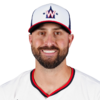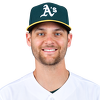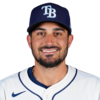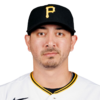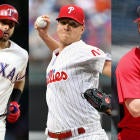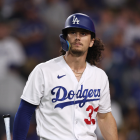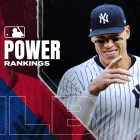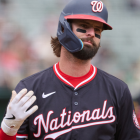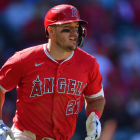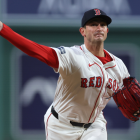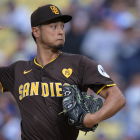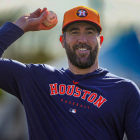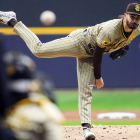Every season, a few players take a big step forward. They might learn a new skill, improve thanks to greater experience, or simply have everything fall into place. When all the stars align, we get a phenomenon that can lead to better numbers, bigger salaries, and even deeper trips into the postseason.
Welcome to the 2019 version of the Breakout Brigade. In this column, I'll highlight seven players who could be ready to take the leap and become significantly better players, even stars. If you don't remember our Breakout Brigade ground rules from past versions of this article, here they are:
A player with remaining rookie eligibility can't be considered a breakout candidate, even if he has already racked up a few at-bats or innings pitched in the big leagues. That disqualifies talented up-and-comers like Vladimir Guerrero Jr., Fernando Tatis Jr., and Eloy Jimenez.
A player who has already made the leap can't put up a breakout season, unless his projected numbers are so far above his previous career bests that he looks like a double-breakout star (like Christian Yelich last year). That disqualifies many already accomplished young players who could continue to perform at a comparable or slightly higher level, including Ronald Acuna Jr. or Blake Snell.
This is about real-life value, not fantasy value. If Jose Alvarado saves 30 games for the Rays, it won't really be a breakout season in any realm other than your 12-team roto league, since Alvarado has already established himself as an excellent relief pitcher. The same goes for a player who moves to the cleanup spot and drives in 120 runs (or to the leadoff spot and scores 100) while putting up other numbers similar to his prior results. A bump in team-dependent counting stats isn't the same thing as a meaningful jump in real-life value.
Here then are seven players primed to make the leap in 2019:

Few players on Earth hit the ball harder than Joey Gallo does. Last season, only Aaron Judge and Nelson Cruz topped Gallo in that department by exit velocity, while Gallo led all of baseball in the frequency with which he smashed the ball on the sweet spot of the bat, as measured by Statcast's barrel percentage. The flip side to that rosy picture is that Gallo is also a strikeout machine, averaging more than 200 whiffs a season over the past two years, while batting a combined .207 over that stretch.
Thing is, Gallo's Kingmanian tendencies are already baked into all his projections, and our perception of him. And even a decade and a half into the Moneyball era, we still can't help but cringe when we see hitters flirting with the Mendoza line every year. The good news for Gallo is that he's thrown off signs that he could get better, both in what he does best and what he does worst.
Best: By those aforementioned categories of barrel percentage and exit velocity, Gallo's improved in each of the past two seasons. Statcast synthesizes those kinds of metrics into a stat called Expected Weighted On-Base Average, a catch-all offensive stat that accounts for quality of contact and runs along a similar scape to regular on-base percentage. By that standard, Gallo was one of the unluckiest players in baseball last season, ringing up a robust .366 Expected Weighted On-Base Average, vs. a more modest actual Weighted On-Base Average of .343.
Squint hard enough, and you can see subtle signs that his cool breeze-delivering abilities at the plate could subside a bit too. Gallo's swinging-strike rate has dropped every year of his major-league career, an encouraging sign. Meanwhile his contact rates, while still ranking near the bottom of the league, have started to tick up, both on pitches in the strike zone and outside the zone.
On top of all that, Rangers general manager Jon Daniels dubbed Gallo one of the team's Core Four, meaning Gallo will get every opportunity to fight through whatever whiffs he rings up. The Rangers are bullish on new hitting coach Luis Ortiz and his plans for improving Gallo's swing. At age 25 and entering his second season as the team's everyday left fielder, Gallo's defense could improve too, giving him a shot to play 150-plus games, and ring up another dinger-filled season.
With a beastly swing and absolute light-tower power, even tiny, subtle changes in Gallo's batting eye and contact rates could pay big dividends. Forget 40 bombs ... there's a 50-homer hitter in here, waiting to emerge.
While Gallo is a key part of the Rangers' present and future, it's tough to think of Chad Pinder as a building-block player. In the past two seasons, he's struck out four times more often than he's walked. He's never earned a full-time gig, instead roaming around the field as a utilityman, but more in the vein of traditional utilitymen than in the Ben Zobrist/Marwin Gonzalez superutility slot that's started to emerge in recent years. In the past two seasons, Pinder has totaled less than 600 combined at-bats.
But despite his modest reputation, Pinder's nearly as much of a Statcast darling as Gallo, generating a .365 Expected Weighted On-Base Average number last season that ranks right there with the Rangers slugger, as well as star hitters like Anthony Rizzo, Juan Soto and Jose Ramirez. Pinder racked up sizable gains in his hard-hit rate and pull rate in 2018, pointing to a potential power breakout on the way. He's not that far off from being a dangerous power hitter as is, launching 28 home runs in that 580-at-bat span over the past two seasons.
Heading into spring training, Pinder sits on the short side of a left-field platoon with lefty-swinging outfielder Nick Martini. But between his versatility, his surprisingly powerful bat, and his upside as he approaches his 27th birthday, Pinder could work his way into something closer to that superutility role, and the 500 plate appearances that could come with it. If that happens, you're looking at a potential 25-homer bat who's going to play everywhere, and possibly help fuel another surprising run for the A's.
Sometimes the simplest path to a breakout is health. David Dahl was the 10th overall pick in the 2012 draft, widely considered a potential impact hitter in the big leagues. Baseball America and Baseball Prospectus both deemed him a top-25 prospect heading into the 2015 season, and top 40 the next year, even after injuries slowed him down.
That 2016 campaign looked like Dahl's coming-out party, as the lefty-swinging outfielder batted .314/.394/.569 across the Double-A and Triple-A levels, and .315/.359/.500 with the big club, appearing in 155 games to boot. It's been back to injury woes since then, with Dahl managing just 19 games played in 2017 (none with the major-league team) and 96 in 2018 (77 with the Rockies). Still, none of these injuries qualify as chronic -- not the stress reaction in his rib cage in 2017, nor the broken foot he suffered after fouling a ball off it last year.
That 77-game sample in 2018 again reinforced Dahl's big-time talent, though, as he rang up 30 extra-base hits in just 249 at-bats with the Rockies. Add to that the Rockies clearing up what was once an outfield logjam by bidding goodbye to multiple players, clearing the way for Dahl to become the team's everyday right fielder, and likely the cleanup hitter batting behind perennial MVP candidate Nolan Arenado to boot. Dahl's going to win a bunch of fantasy leagues for his lucky speculators, and entering his age-25 season, he'll become the latest homegrown standout in the mile-high city.
You might not find 10 players in all of baseball with a better batting eye than Jesse Winker, even if one of those less-than-10 happens to be the franchise player on the same team. In 89 games last season, Winker walked 49 times and struck out just 46 times, lifting him up to the ranks of Jose Ramirez, Alex Bregman, Mike Trout and Joey Votto. As a result, Winker rang up a majestic .405 on-base percentage that ranked sixth in the majors among hitters with 300 or more plate appearances, behind the likes of Trout, Mookie Betts, and yes, Mr. Votto too.
Granted, the seven home runs Winker hit last season didn't exactly terrify opposing pitchers. But he's got solid gap power, banging out 29 doubles across the majors and Triple-A in 2017. He's also entering his age-25 season, where he'll finally get the chance to play everyday, health permitting.
He could conceivably need a little time to regain the full measure of his power as his shoulder heals. Then again, he's suffered shoulder injuries in the past and slugged his way through them anyway. Think of Winker as a kind of Shin-Soo Choo starter kit, capable of racking up 100 walks, 40 doubles, and 15-plus homers if given 600-plus times at the dish. That makes him an absolutely ideal leadoff man in what could be a potent Reds lineup.
That's right, it's not one, not two, but three Phillies starting pitchers! And just as Aaron Nola broke out to stardom last season, Nick Pivetta, Zach Eflin and Vince Velasquez have a chance to each take steps forward this year, albeit with less upside than the team's Cy Young-caliber ace.
Start with Pivetta, one of the most prolific strikeout pitchers in the league. Dig this, from last season:
2018 National League strikeout rate leaders
- Max Scherzer: 34.6 percent
- Jacob deGrom: 32.2 percent
- Patrick Corbin: 30.8 percent
- German Marquez: 28.2 percent
- Mike Foltynewicz: 27.2 percent
- Nick Pivetta: 27.1 percent
- Aaron Nola: 27 percent
When you're in that kind of company -- above even the all-world pitcher on your team -- you've got lots of upside. Pivetta is one of the hardest-throwing starters in the league, with a fastball that averages a hair less than 96 mph. But while he throws that heater more than half the time, his go-to offering is a nasty curveball, one that held opponents to a .208 batting average and a .289 slugging average last season.
To take the next step, Pivetta needs to do a better job locating his fastball, and also get a little more luck on his side: In his two-year major-league career, he's stranded just 68.1 percent of the runners he's put on base, while allowing home runs on 17 percent of the flyballs he's induced. Both those stats rank among the 10 worst in the NL over the past seasons, and both could be ripe for some serious positive regression this year.

Eflin took a huge step forward in 2018, adding nearly two miles per hour on his fastball to hike it to a 95-mph offering. In related news, he engineered one of the biggest jumps in whiff rate for any pitcher in the league, got ahead in the count 0-1 more often, and also went from one of the tiniest and most unplayable strikeout rates in the league to punching out nearly a batter an inning. Eflin too got dinged by a flukishly low strand rate, and just needs seven or eight more starts, plus a little more luck, to emerge as a quality number-three starter on a team that will slot him fourth or fifth.
By fielding-independent pitching Velasquez was the best of this trio, ringing up a solid 3.75 FIP. He was a prolific strikeout pitcher in his own right, whiffing 25.6 percent of the batters he faced, but with a park-adjusted home-run rate that was better than league average. Plagued by injuries in his first two years with the Phillies, Velasquez made a career-high 30 starts in 2018 too.
The problem is one of longevity, and big innings. Velasquez averaged less than five innings per start, an absurdly low number even in today's era of 900-man bullpens and managers panicking over the prospect of starters facing a lineup for the third time in a game. Stop me if you've heard this one, though: Velasquez got hurt the worst once he put men on base, stranding just 66.8 percent of the runners who reached against him, the third-lowest number among NL starters with as many innings pitched, and a figure that's similarly ripe for some better luck and positive regression.
Now consider the common denominator between these three promising underachievers. If you're a pitcher whose basic numbers don't stack up with his fielding-independent numbers, with an added tendency to get into trouble and allow big innings, one of the best remedies you can hope for is a defense behind you that can clean up your messes. Lo and behold, the Phillies fielded the single worst defense in all of baseball last year, allowing a jarring 146 more runs than the average team on glove-work alone (per Baseball Info Solutions' Defensive Runs).
The Phillies probably aren't done shopping this offseason, given all the flashy rumors surrounding their interest in stars Bryce Harper and Manny Machado. But at a minimum, Philly should be substantially better defensively in 2019 just by moving overmatched left fielder Rhys Hoskins back to first baseman following the trade of Carlos Santana, and replacing a bumbling cast of many butchers at short and in right field with better-than-average fielders in Jean Segura and Andrew McCutchen.
If Harper proves to be the final piece of Philly's hot stove puzzle, don't expect the defense to take any additional jumps. But if Machado ends up being the last fish that the Phillies reel in, the former Oriole who reminded us of Brooks Robinson could be the final piece to the puzzle who helps supercharge the Phillies' number-three, -four, and -five starters into simultaneous, and maybe even spectacular breakouts.







